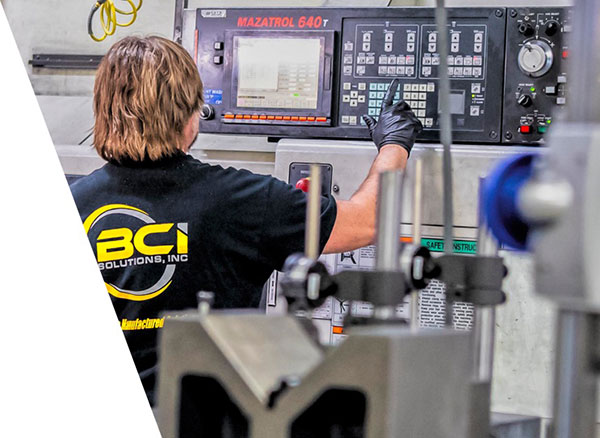Specialty Machining

Specialty Machining
In addition to your typical CNC Turning and Milling Centers, BCI Solutions, Inc. also offers an array of other solutions for your manufacturing needs, which would include but not limited to: Broaching, Balancing, Surface Grinding, and Laser Engraving.
Broaching
Broaching is a machining process that uses a toothed tool, called a broach, to remove unwanted material internally or externally from a workpiece. There are two broaching processes, linear and rotary. Broaching is typically used for high quantity production and precise applications.
What is a Broach?
CNC milling and CNC turning are best used as secondary finishing processes. Which process to use depends on what the workpiece is and what type of cuts are needed. CNC Milling operations are best used for flat or sculptured surfaces on square or rectangular blocks. CNC Turning operations are best used for cylindrical or conical workpieces. The workpiece is held by a lathe and spun at high RPMs while the moving cutters shave away the unwanted materials.
Balancing
Balancing is critical for all rotating parts. If parts are not balanced, rotating can cause noise, component wear, excessive vibration, a reduction of bearing life, and subsequently a premature component failure. In order to ensure a balanced finished product, BCIS uses a balancing machine to balance rotating machine parts, such as rotors for disc brakes. The object or part being tested is bolted to a platform on the machine and rotated. As the part is rotated, the vibration in the suspension is detected with sensors and that information is used to determine the amount of unbalance in the part. The machine can determine how much and where to add or remove weights to balance the part.
Types of Balancing
There are two main types of balancing, static and dynamic. In static balancing, the object is held at its axis, then mass is removed or added to compensate for the heavier side of the object. In static balancing the object does not rotate. Static balancing is typically done on flat parts. Dynamic balancing is done on parts that are long compared to their diameters. These parts require balancing to be done in two planes since the actual imbalance will intersect the axis. Unless both ends of the part are balanced, mass imbalance will continue to exist.
Surface Grinding
Surface grinding is a widely used abrasive machining process in which a spinning wheel covered in rough particles, called a grinding wheel, cuts chips of metallic or nonmetallic substance from a workpiece, to produce a smooth finish on flat surfaces. Surface grinding is the most common of the grinding operations. It is a finishing process that uses a rotating abrasive wheel to smooth the flat surface of metallic or nonmetallic materials, to give them a more refined look or to attain a desired surface for a functional purpose. Typical workpiece materials include cast iron and mild steel. Other materials are aluminum, stainless steel, brass, some plastics, ceramics and composite materials.
Laser Engraving
Laser engraving creates permanent, high-quality marks on parts during production. Laser marking is fast and maintenance-free, making it an attractive alternative to other forms of marking like ink jet marking, chemical etching, or the application of labels.